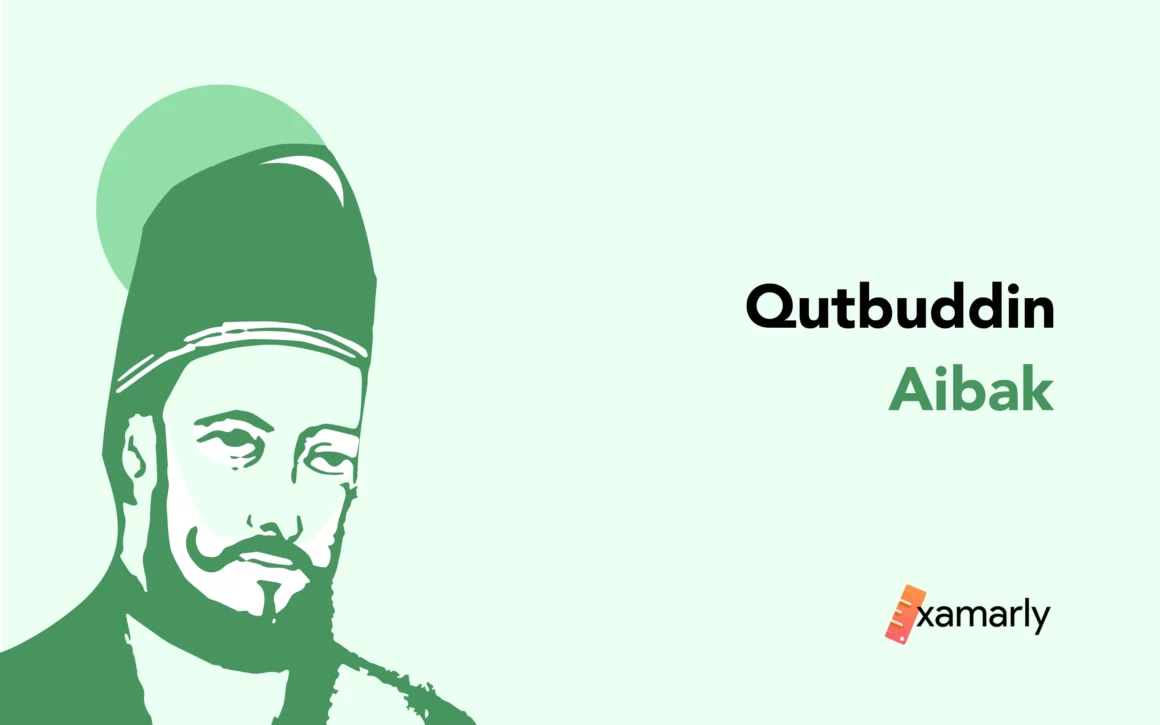Before he became the ruler of Delhi, Qutbuddin Aibak was a general under the Ghurid king Muhammad Ghori. After the sultan Muhammad Ghori’s death, Qutb ud-Din Aibak took charge of the Ghurid land territory in the area of northern India, and then became the ruler of an independent kingdom. He was also the first sultan of Delhi, and this article will explore his life and achievements.
Early Life of Qutub-ud-din-Aibak
The Early Life of Qutbuddin Aibak began during the time of period in which Ghurid Empire was at its peak. Ghori’s death in 1206 left no son, so Aibak was named Viceroy of the Indian empire. The Ghori family honored Aibak by giving him titles such as “God of the Moon”.
In his early life, Qutbuddin Aibak was born into a high-class family in the Turkistan region. He was brilliant and impressive. He was been sold into slavery at a young age and later sold to the Qazi of Nishapur, who educated him. After Qazi’s death, Qutbuddin Aibak was purchased by Muhammad Ghori, who provided him with an education and a good living. He eventually rose to the first rank of commander of a troop.
Qutbuddin Aibak was a Turk from the Aybak tribe. He became the first sultan of the region Delhi as Sultanate, ruling for only four years. During his time as sultan, he fought noble rebellions, restored the peace and prosperity of the region, and he started the building process of the Quwaat-al-Islam Mosque in Delhi.
Religion of Qutb ud-Din Aibak
Aibak, who fought for the Muslim cause in Afghanistan, was born in Turkestan to a Turk family.
While Aibak’s religious beliefs are based on the Koran, he had a reputation for destroying Hindu temples and slaughtering pagans. His religion was also based on force, which is how he converted many men who opposed him. He converted the clever and savvy garrison members of the Koil city and massacred their enemies. But he spared the women and children because they were regarded as slaves.
Related – As the Ghurid Sultan’s subordinate
Qutb-Ud-Din As A Ruler Of Delhi
In the medieval period of India, the Muslim Dynasty governed the Delhi Sultanate. Qutb-ud-din Aibak was the first Muslim monarch of Delhi and His dynasty was known as the slave dynasty.
After ascending the throne, Qutb-ud-din faced many challenges both inside and outside Delhi. Turkish officers envied him and were not loyal. At the same time, the Rajputs grew impatiently awaiting an opportunity to strike. Qutb-ud-din was incapable to deal with all these challenges and eventually fell victim to a series of political intrigues.
The first ruler of Delhi was not successful. Khwarizm Shah Ala-ud-din Muhammad had wanted to capture Delhi and Ghazni. However, Qutb-ud-din Aibak was determined to stay independent and built a strong position in the capital city. He persuaded most of the Turkish nobles living in Delhi to surrender to him. Among other military strategies he came up with, one was also subjugating areas between the Ganges and the Yamuna Rivers.
Advancement & Military Conquest of Qutb ud-Din Aibak
The real creator of Turkish rule in India was Qutb ud-Din Aibak. He was the key factor in Sultan Muhammad Gori’s success in India and consolidated those conquests after the sultan died. He established supremacy over the nobles of Turkey and defeated two rivals for the city of Delhi.
Aibak was named Viceroy of the Ghori provinces in India after the second battle of Tarain, which was won by the Ghori army. For the emerging Muslim empire, he rendered heroic duty. From 1192 to 1205, he continued his master’s run of victories even while he was away, putting an end to Rajput uprisings. Along with organizing the Ghori-conquered regions, he also increased the size of his empire.
The first thing Aibak did was invade Hansi’s fort and seize control of it. Later, in A.D. 1193, he defeated the Tomar king and took control of Delhi. He triumphed over Meerut and Bulandshahar that same year. Ghori again entered India in 1194 A.D. to revenge Jaichand, king of Kannauj. Aibak significantly aided his master throughout this invasion. After defeating Kannauj, Ghori turned the province or its leadership over to Aibak.
You Might Also Like – Tughlaq Dynasty: Medieval Indian History UPSC Notes
Achievements Of Qutub-ud-din-Aibak
- One of the most remarkable achievements of Aibak’s reign is his conquest of a region between the Ganges and the Yamuna, also known as the Deccan. During his four years of ruling period in India, Aibak defeated various rivals and revolts and established law and order. He strengthened the army and built mosques throughout the country, including the famous Jama Masjid in Delhi. Although Aibak’s rule failed, he remains a prominent figure in history for his conquests of India.
- Aibak also captured twenty thousand slaves and a large number of cattle beyond calculation. His conquest of India reshaped the Muslim world and strengthened the infant Islamic empire. The achievements of Qutbuddin Aibak are extensive and include the conquest of Ajmer, Bhilwara, and parts of the U.P.
- Despite the other noble ones like Taj-ud-din Ildiz and Nasir-ud-din Qubachah, he strongly built the administrative system, which had been originally established by Ghori though.
- Qutubuddin Aibak is the one who initiated the construction process of the mosque Quwwat-ul-Islam which was the earliest Muslim monument in Delhi, but he could not complete them.
- Aibak was known as the “Lakh Baksh” (Lakh’s king), and most scholars consider him the founder of Mulsim rule in India.
- Aibak built the Adhai din ka Jhonpra mosque in Ajmer city.
- He began the construction of Qutb Minar in Delhi. Qutub Minar’s construction was finished by Aibak’s son-in-law and successor Iltutmish. He fully completed the construction work of the Quwwat-ul-Islam mosque and the Qutb Minar.
Sultan And Slave Dynasty
In Indian history, The Mamluk Dynasty was the first dynasty to rule Delhi. The Mamluk dynasty originated in Northern India by Qutb ud-Din Aibak, a Turkic slave general of the Central Asian Ghurid Empire. The Mamluk dynasty was ruling from 1206 until 1290, becoming the first of a few dynasties to rule the Delhi Sultanate until 1526.
The Slave Dynasty of Qutubuddin Aibak began with the death of the Ghurid Empire under Muhammad of Ghor. His whole empire was divided into smaller sultanates, with Taj-ud-Din Yildoz ruling Ghazni, Muhammad bin Bakhtiyar Khilji ruling Bengal, and Nasir-ud-Din Qabacha ruling Multan and Delhi. The Slave Dynasty of Qutbud-ud-din Aibak also gave us the Taj-ud-Din Aibak monument in Delhi. slave dynasty was technically the first dynasty to rule as the Delhi Sultanate.
He was turned down by Shamsuddin Iltutmish, some other slave who became the level of Sultan, thus promoting the Slave/Mamluk Dynasty. After his death, Balbun appointed his son Kaimurs as his successor. He also instituted the coin currency Tanka and he was the one who completed the construction work of the Qutub Minar. His daughter Raziya Sultan was nominated as his heir. However, she faced opposition to her appointment as a woman. Her successor in Delhi, Ghiyasuddin Balban, started from 1266 to 1286, strengthened the administration and paid attention to governance in the empire.
Death and Succession of Qutub-ud-din-Aibak
The death and succession of Qutbuddin Aibak are one of the most head-turning events in Islam.
After Qutubuddin Aibak’s death, two other sultans were appointed to succeed him: Aram Shah and Iltutmish. Aram Shah was named as the successor of Qutbuddin Aibak to prevent any further instability in the kingdom. He was manipulated by a set of noble persons who declared the Shamsuddin Iltutmish to be their ruler.
Once, While playing the game of Chauhan (horse polo), he fell from his noble horse and soon came his death in 1210 A.D. he was buried at Lahore and a very simple monument was built over his grave for remembrance.
Conclusion
Qutub ud-Din Aibak, (1150–1210), was born in a Turk Tribe known as Aybak in central Asia and was sold as a slave in his childhood, later on, Qutub ud-Din Aibak was purchased by the ruler of Ghor in Central Afghanistan and became the commander of Sultan Ghori. He was the founder of the Mamluk Dynasty also known as the Slave Dynasty. He crowned himself as the Sultan of the Delhi Sultanate in 1206. He started building many Muslim monuments in Delhi and is most remembered for the construction of Qutub Minar. He died in the year 1210 while playing polo and was succeeded by his son-in-law Shams ud-Din Iltutmish.
FAQs
What was Qutbuddin Aibak also known as?
Due to his huge generosity, the man Qutub-ud-din Aibak was referred to as Lakha Baksh Sultan.
Who built Qutub Minar?
In 1200 AD, Aibak started building the Qutab Minar, but he could only complete the basement. Three further stories were added by his successor Iltutmush, while the fifth and last floor was built in 1368 by Firoz Shah Tughlak.
Who was the first person mentioned as the Sultan of Delhi?
Qutb-ud-din Aibak proclaimed himself the first person to be called sultan of Delhi.
Why is Qutubuddin Aibak famous?
Qutb-ud-din Aibak was a prominent figure in history, transforming the loosely held Ghurid provinces of middle India called the powerful person Delhi Sultanate.






